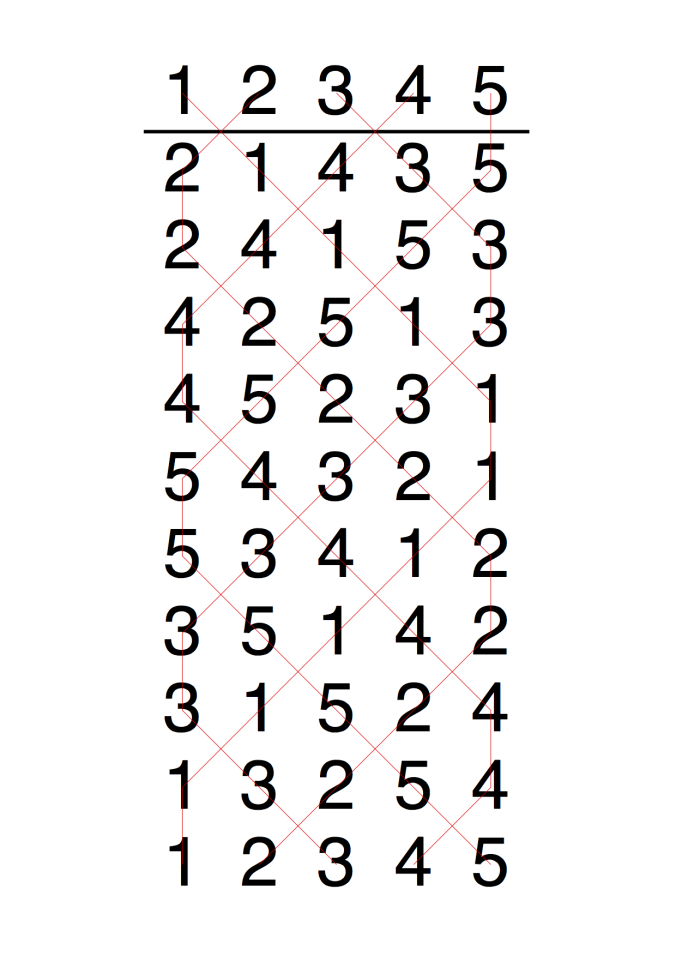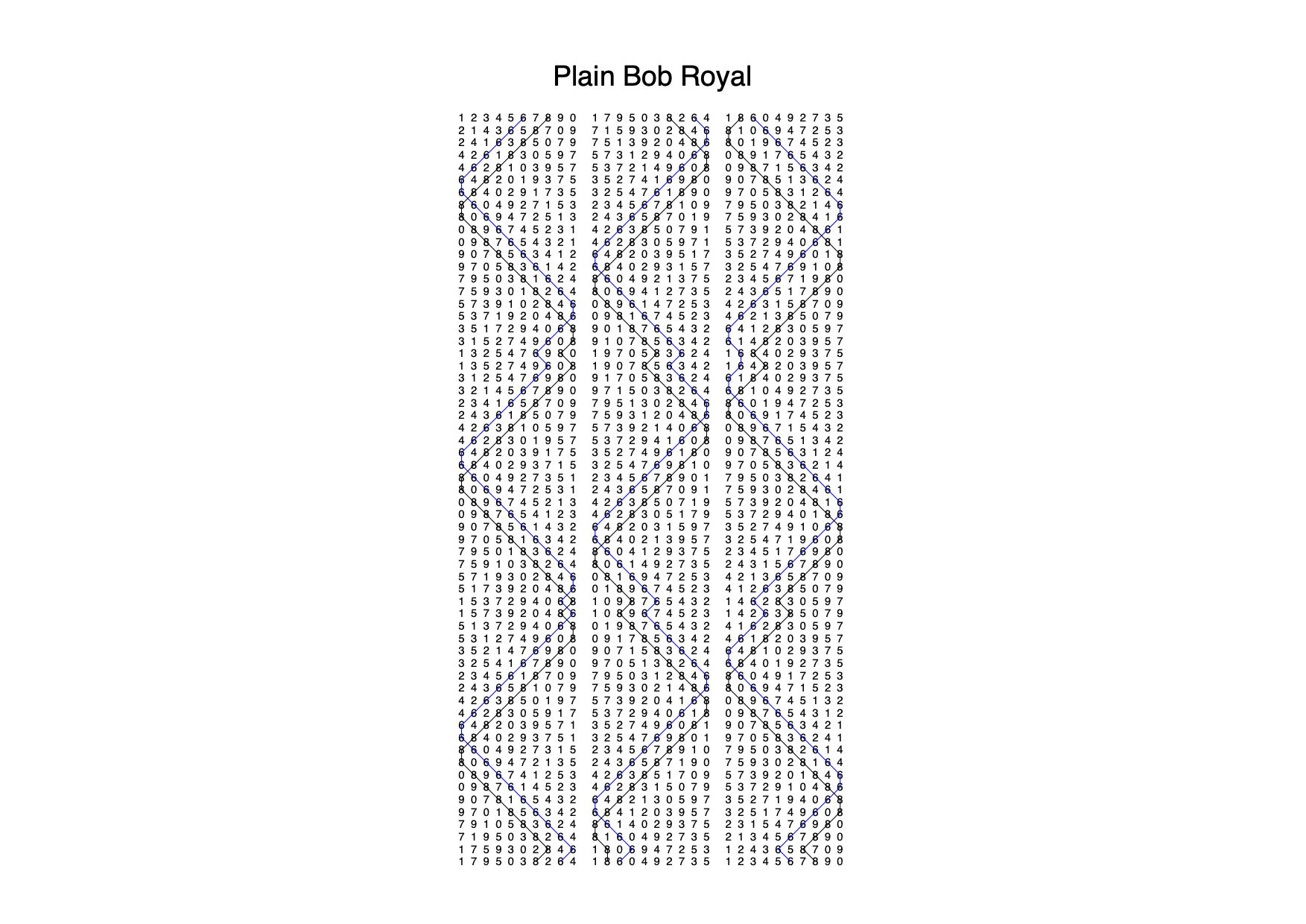23: Coursing Order
Have another look at the rows in Plain Hunt on 5. Lines have been drawn through all the bell numbers to show you how each bell moves. Remember:
- The front of each row is at the left.
- The back of each row is at the right.
- Each bell, having arrived at lead hunts up to the back (left to right), lies behind, and then hunts down to the front (right to left)

Now, let's make one or two things clear, if they weren't already:
- Each bell does the same thing, but they all start in different places.
- Odd numbered bells start by hunting up.
- Even numbered bells start by hunting down.
By looking at the lines, can you see how each bell follows one of the other bells around? For example, imagine you are hunting the 4th. You should be able to see that it follows the 2nd down to lead and then, having led, follows it up to the back before following it back in towards the front. Similarly the 5th follows the 4th around and the 3rd follows the 5th around. This manner in which bells follow each other around as they hunt is the essential idea behind coursing order.
There's a natural tendency to think that ringing is simpler with fewer bells. However that's not always true, as anyone who has tried to ring well-struck Plain Hunt on three will tell you. In fact, the patterns and regularities in ringing often become much clearer on a higher number of bells. Coursing order is a good example; it's much easier to see the way in which one bell follows another one round if there is a larger number of bells and a longer piece of ringing (had it dawned on you that the greater the number of bells the more rows you have in a plain course of pretty much anything?). Here's a plain course of Plain Bob Royal, with lines drawn through the 6th and the 8th. All other lines have been taken out. Notice that the tenor (bell number 10) is represented by the symbol '0'.

This diagram shows very clearly that, pretty much all of the time, the 8th follows the 6th round the plain course of Plain Bob Royal. In fact, every bell apart from the treble has a bell that it follows round, and consequently it also has a bell that follows it round.
- The bell that you follow round is called your course bell.
- The bell that follows you around is called your after bell.
Notice in particular that:
- You arrive at lead and at the back immediately after your course bell.
- You are always taken off lead by your after bell.
- Your after bell arrives at the back as you start to hunt down.
- In Plain Bob, as you hunt there is always one bell between you and your course bell, and between you and your after bell.
The four points above are very useful in helping you see where you are in the method. In particular:
- You know which bell is going to take you off lead as you start to hunt up (your after bell).
- You know which bell to look for at the back as you start to hunt down (again, your after bell).
- You know which bell you're going to lead after (your course bell). Indeed, if you get lost when hunting down, the conductor may well say 'get behind such and such a bell'. That bell will be your course bell, so look for it and try to follow it with enough space between you and it for one other bell. Definitely make sure you're not in front of it!
- Similarly, if you get lost hunting up, at least make sure you stay above your after bell.
All this is somewhat messed up by the treble, who you will remember is doing his or her own thing. Because it's not doing the same as everyone else, it isn't fixed in the coursing order and it can, and will, sometimes come between you and your course bell or you and your after bell. If you have another look at the diagram of Plain Bob Royal, you'll see that this happens for the 6th and 8th in the top right hand corner of the diagram (the 7th lead of the method). In that lead, the 6th and 8th are hunting with the treble coursing between them and there are three bells between them in each row. It's caused by the 8th making 2nds over the treble and put right when the 6th makes 2nds at the end of the lead.
So far, we've talked more about coursing than we have about coursing order. It's time for some definitions.
- Coursing order is the order in which bells arrive at the back, excluding the treble. From the diagram of Plain Bob Royal we can see that the coursing order is:
975324680
- Adjacent pairs of bells in the coursing order are called 'coursing pairs'.
- Pairs of bells which don't course are called 'non coursing pairs'.
- Because this particular coursing order (975324680) forms the basis of the majority of methods, it is known as 'natural coursing order'.
- In some methods e.g. Superlative S Major, pairs of bells arrive at the back not in natural coursing order. Those pairs are also called non-coursing pairs. If your're interested, you could find a diagram of Superlative and check this out, but it's really not essential at this stage.
975324680 is, of course the natural coursing order on ten bells. If you want to work out natutral coursing order on any othe number of bells, it's easy. You start with the largest odd-numbered bell, go up the odd numbers until you get to 3, then come back down the even numbers, starting with 2. Here are the natural coursing orders on all numbers of bells from Doubles to Maximus:
- Doubles: 5324
- Minor: 53246
- Triples: 753246
- Major: 7532468
- Caters: 97532468
- Royal: 975324680
- Cinques: E975324680
- Maximus: E975324680T (notice that we use 'E' for the 11th and 'T' for the 12th).
If you now return to the diagram of Bob Doubles, you should be able to see how the natural coursing order, 5324, is present throughout the plain course. Just remember that the treble moves through the coursing order, so there will be leads when the treble seperates you from your course bell or your after bell. Choose a bell and see if you can see hoe that works in the diagram.
There's more to say about coursing order, but I'm saving it for the next lesson.



